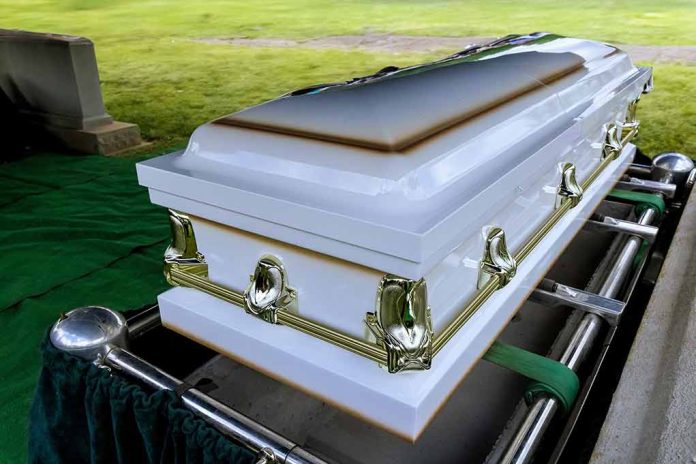
Russian families are burying strangers in sealed coffins while their “dead” loved ones are sometimes found alive elsewhere, exposing the Kremlin’s desperate attempt to hide the true cost of Putin’s Ukraine disaster.
Key Takeaways
- Russian authorities are prohibiting families from opening sealed coffins of supposedly deceased soldiers, threatening legal action if they attempt to verify identities.
- Multiple documented cases exist of families burying the wrong bodies, including instances where the “deceased” soldier later contacted family members alive.
- Officials refuse to provide personal belongings, photographs, or allow DNA testing that could confirm identities, creating profound uncertainty for grieving families.
- With an estimated 250,000 Russian soldiers killed in Ukraine, the sealed-coffin policy appears designed to hide the true scale of casualties and maintain Putin’s domestic narrative.
- Families are left in perpetual limbo, not knowing if they’ve buried their loved one or a stranger, fostering hope that missing soldiers might still be alive.
Kremlin’s Deception Through Sealed Coffins
In remote villages and cities across Russia, a disturbing ritual plays out with increasing frequency. Military officials arrive with sealed coffins supposedly containing fallen soldiers, but with strict orders that the caskets must never be opened. Valeria Mikhailova experienced this firsthand when authorities delivered what they claimed was her husband Maksim’s body. Officials threatened severe consequences if the family attempted to verify the remains, leaving Valeria with a haunting uncertainty that persists to this day.
“The [officials] threatened that they will launch a criminal probe against us if we open the coffin without permission. I begged them to show me at least a photo of the body [taken before it was placed in the coffin] to see how it looked like. They didn’t have any. They didn’t allow us to do a DNA test,” said Valeria Mikhailova .
The Kremlin’s policy creates profound psychological torture for families, denying them both closure and certainty. Officials claim opening coffins violates law, though no such legislation exists. What began during Russia’s initial “ghost soldier” deployments in 2014 has evolved into systematic deception on an industrial scale, with authorities apparently more concerned with controlling the war’s narrative than providing dignity to fallen troops or comfort to bereaved families.
The Living Dead: When Buried Soldiers Return
In a macabre twist that undermines the entire sealed-coffin policy, multiple families have discovered they buried complete strangers or empty coffins. In Buryatia, one family received both a coffin and death certificate for a soldier named Sergei K., only to later receive a shocking phone call from the very man they had mourned and buried – alive and recovering in a hospital. A family in Yekaterinburg was forced to hold a second funeral after discovering they had buried someone else entirely.
“I often think, ‘Who did I bury?’ I don’t know,” stated Valeria Mikhailova .
These administrative “errors” reveal the chaotic reality behind Russia’s management of war casualties. Ukrainian officials have accused Moscow of returning mutilated bodies with mixed body parts, further complicating identification efforts. The sealed-coffin policy seems designed not just to hide numbers, but to conceal the brutal condition of remains that would contradict the Kremlin’s sanitized version of the conflict presented to Russian citizens.
Silencing Grief and Suppressing Truth
The Committee of Soldiers’ Mothers estimates at least 500 Russian soldiers died in Ukraine’s early conflict phases alone, with current estimates suggesting up to 250,000 Russian troops killed since the war began. Yet families seeking information face bureaucratic stonewalling, threats, and sometimes outright hostility from military officials. Those who pursue answers find themselves navigating a labyrinth of contradictions and lies, as Valentina Mikhailova discovered while investigating her son’s supposed death.
“Everyone around has lied about it. The military enlistment office told us that his body… was identified by his fellow soldiers and his commander, and that there was no need for a DNA test. Then, it turned out that his fellow soldiers had lost him altogether and there was no identification at all,” said Valentina Mikhailova .
The pattern of deception extends beyond individual families. Independent journalists and politicians investigating these deaths have faced threats and violence. When bereaved relatives press for details, they’re sometimes offered insulting dismissals, as one officer told a grieving family: “Quit calling. They’ll give you 100,000 rubles ($1,850) — more than enough to drink and remember him. What more do you want?” This callousness reveals the regime’s true priorities – maintaining Putin’s political standing over honoring sacrifices made in his name.
Hope Amid Despair
For many Russian families, the uncertainty of sealed coffins creates a perverse form of hope. Without definitive proof of death, they cling to the possibility their loved ones might still be alive – as prisoners of war, hospitalized, or simply lost in the bureaucratic chaos. This psychological limbo represents yet another burden imposed by a government willing to sacrifice its citizens twice: first in an unnecessary war, then in a campaign of deception designed to hide the true costs of Putin’s imperial ambitions.
Some families, like the Mikhailovs, refuse to accept official explanations and are pursuing court orders for DNA testing. Their persistence exposes the fundamental weakness in Putin’s information control strategy. While propaganda can temporarily mask reality, the truth eventually emerges – often through the determined efforts of ordinary citizens seeking answers about their loved ones. The sealed coffins of Russia have become powerful symbols of a government at war not just with Ukraine, but with truth itself.



